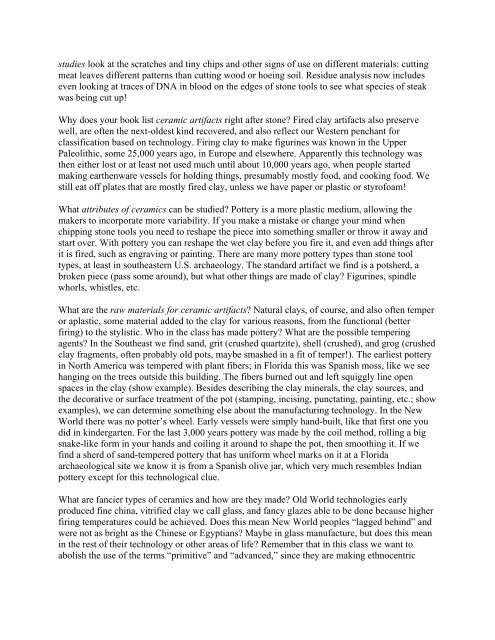INTRODUCTION TO ARCHAEOLOGY Nancy White - Touro Institute
INTRODUCTION TO ARCHAEOLOGY Nancy White - Touro Institute
INTRODUCTION TO ARCHAEOLOGY Nancy White - Touro Institute
Create successful ePaper yourself
Turn your PDF publications into a flip-book with our unique Google optimized e-Paper software.
studies look at the scratches and tiny chips and other signs of use on different materials: cutting<br />
meat leaves different patterns than cutting wood or hoeing soil. Residue analysis now includes<br />
even looking at traces of DNA in blood on the edges of stone tools to see what species of steak<br />
was being cut up!<br />
Why does your book list ceramic artifacts right after stone? Fired clay artifacts also preserve<br />
well, are often the next-oldest kind recovered, and also reflect our Western penchant for<br />
classification based on technology. Firing clay to make figurines was known in the Upper<br />
Paleolithic, some 25,000 years ago, in Europe and elsewhere. Apparently this technology was<br />
then either lost or at least not used much until about 10,000 years ago, when people started<br />
making earthenware vessels for holding things, presumably mostly food, and cooking food. We<br />
still eat off plates that are mostly fired clay, unless we have paper or plastic or styrofoam!<br />
What attributes of ceramics can be studied? Pottery is a more plastic medium, allowing the<br />
makers to incorporate more variability. If you make a mistake or change your mind when<br />
chipping stone tools you need to reshape the piece into something smaller or throw it away and<br />
start over. With pottery you can reshape the wet clay before you fire it, and even add things after<br />
it is fired, such as engraving or painting. There are many more pottery types than stone tool<br />
types, at least in southeastern U.S. archaeology. The standard artifact we find is a potsherd, a<br />
broken piece (pass some around), but what other things are made of clay? Figurines, spindle<br />
whorls, whistles, etc.<br />
What are the raw materials for ceramic artifacts? Natural clays, of course, and also often temper<br />
or aplastic, some material added to the clay for various reasons, from the functional (better<br />
firing) to the stylistic. Who in the class has made pottery? What are the possible tempering<br />
agents? In the Southeast we find sand, grit (crushed quartzite), shell (crushed), and grog (crushed<br />
clay fragments, often probably old pots, maybe smashed in a fit of temper!). The earliest pottery<br />
in North America was tempered with plant fibers; in Florida this was Spanish moss, like we see<br />
hanging on the trees outside this building. The fibers burned out and left squiggly line open<br />
spaces in the clay (show example). Besides describing the clay minerals, the clay sources, and<br />
the decorative or surface treatment of the pot (stamping, incising, punctating, painting, etc.; show<br />
examples), we can determine something else about the manufacturing technology. In the New<br />
World there was no potter’s wheel. Early vessels were simply hand-built, like that first one you<br />
did in kindergarten. For the last 3,000 years pottery was made by the coil method, rolling a big<br />
snake-like form in your hands and coiling it around to shape the pot, then smoothing it. If we<br />
find a sherd of sand-tempered pottery that has uniform wheel marks on it at a Florida<br />
archaeological site we know it is from a Spanish olive jar, which very much resembles Indian<br />
pottery except for this technological clue.<br />
What are fancier types of ceramics and how are they made? Old World technologies early<br />
produced fine china, vitrified clay we call glass, and fancy glazes able to be done because higher<br />
firing temperatures could be achieved. Does this mean New World peoples “lagged behind” and<br />
were not as bright as the Chinese or Egyptians? Maybe in glass manufacture, but does this mean<br />
in the rest of their technology or other areas of life? Remember that in this class we want to<br />
abolish the use of the terms “primitive” and “advanced,” since they are making ethnocentric
















